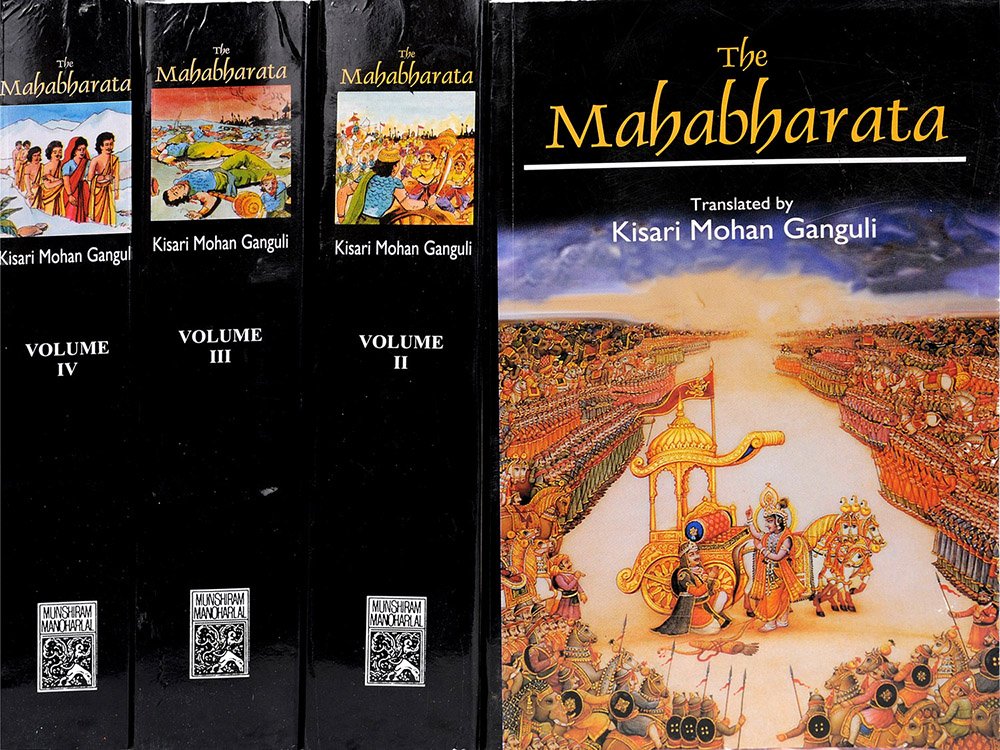Mahabharata (English)
by Kisari Mohan Ganguli | 2,566,952 words | ISBN-10: 8121505933
The English translation of the Mahabharata is a large text describing ancient India. It is authored by Krishna-Dwaipayana Vyasa and contains the records of ancient humans. Also, it documents the fate of the Kauravas and the Pandavas family. Another part of the large contents, deal with many philosophical dialogues such as the goals of life. Book...
Section LVI
Sanjaya said,—
"When the night having passed away, the dawn came, Santanu’s son Bhishma, that chastiser of foes, gave the order for the (Kuru) army to prepare for battle. And the son of Santanu, the old Kuru grandsire, desirous of victory to your sons, formed that mighty array known after the name of Garuda. And on the beak of that Garuda was your sire Devavrata himself. And its two eyes were Bharadvaja’s son and Kritavarman of Satwata’s race. And those renowned warriors, Asvatthaman and Kripa, supported by the Trigartas, the Matsyas, the Kekayas, and the Vatadhanas, were in its head. And Bhurisravas and Sala, and Salya and Bhagadatta, O sire, and the Madrakas, the Sindhu-Souviras, and they that were called the Panca-nodas, together with Jayadratha, were placed on its neck. And on its back was king Duryodhana with all his followers. And Vinda and Anuvinda of Avanti, and the Kamvojas with the Sakas, and the Surasenas, O sire, formed its tail, O great king.
And the Magadhas and the Kalingas, with all the tribes of the Daserakas, accoutred in mail, formed the right wing of that array. And the Karushas, the Vikunjas, the Mundas, and the Kaundivrishas, with Vrithadvala, were stationed on the left wing. Then that chastiser of foes, Savyasachin, beholding the host disposed in battle-array, aided by Dhrishtadyumna, disposed his troops in counter-array. And in opposition to that array of thine, the son of Pandu formed fierce array after the form of the half-moon. And stationed on the right horn, Bhimasena shone surrounded by kings of diverse countries abundantly armed with various weapons.
Next to him were those mighty car-warriors Virata and Drupada; and next to them was Nila armed with envenomed weapons. And next to Nila was the mighty car-warrior Dhrishtaketu, surrounded by the Chedis, the Kasis, the Karushas, and the Pauravas. And Dhrishtadyumna, and Sikhandin, with the Pancalas and the Prabhadrakas, and supported by other troops, were stationed in the middle, O Bharata, for battle. And thither also was king Yudhishthira the just, surrounded by his elephant division. And next to him were Satyaki, O king, and the five sons of Draupadi. And immediately next to them was Iravan. And next to him were Bhimasena’s son (Ghatotkacha) and those mighty car-warriors, the Kekayas. And next, on the left horn (of that array), was that best of men, viz., he who had for his protector, Janardana—that protector of the whole Universe. It was thus that the Pandavas formed their mighty counter-array for the destruction of your sons and of those who had sided with them.
Then commenced the battle between your troops and those of the foe striking one another, and in which cars and elephants mingled in the clash of combat. Large numbers of elephants and crowds of cars were seen everywhere, O king, to rush towards one another for purposes of slaughter. And the rattle of innumerable cars rushing (to join the fray), or engaged separately raised a loud uproar, mingling with the beat of drums. And the shouts of the heroic combatants belonging to your army and theirs, O Bharata, slaying one another in that fierce encounter, reached the very heavens."
Conclusion:
This concludes Section LVI of Book 6 (Bhishma Parva) of the Mahabharata, of which an English translation is presented on this page. This book is famous as one of the Itihasa, similair in content to the eighteen Puranas. Book 6 is one of the eighteen books comprising roughly 100,000 Sanskrit metrical verses.
FAQ (frequently asked questions):
Which keywords occur in Section LVI of Book 6 of the Mahabharata?
The most relevant definitions are: Karushas, Santanu, Kuru, Garuda, Dhrishtadyumna, Bhimasena; since these occur the most in Book 6, Section LVI. There are a total of 55 unique keywords found in this section mentioned 64 times.
What is the name of the Parva containing Section LVI of Book 6?
Section LVI is part of the Bhagavat-Gita Parva which itself is a sub-section of Book 6 (Bhishma Parva). The Bhagavat-Gita Parva contains a total of 112 sections while Book 6 contains a total of 3 such Parvas.
Can I buy a print edition of Section LVI as contained in Book 6?
Yes! The print edition of the Mahabharata contains the English translation of Section LVI of Book 6 and can be bought on the main page. The author is Kisari Mohan Ganguli and the latest edition (including Section LVI) is from 2012.
